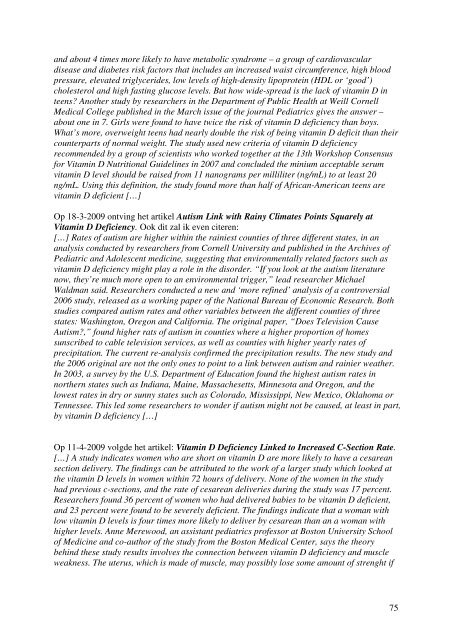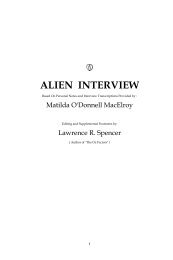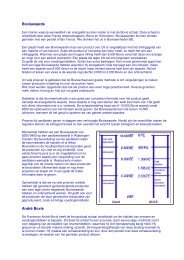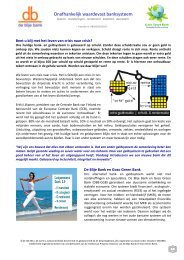De verborgen gevaren van vaccinaties - WantToKnow.nl
De verborgen gevaren van vaccinaties - WantToKnow.nl
De verborgen gevaren van vaccinaties - WantToKnow.nl
You also want an ePaper? Increase the reach of your titles
YUMPU automatically turns print PDFs into web optimized ePapers that Google loves.
and about 4 times more likely to have metabolic syndrome – a group of cardiovascular<br />
disease and diabetes risk factors that includes an increased waist circumference, high blood<br />
pressure, elevated triglycerides, low levels of high-density lipoprotein (HDL or ‘good’)<br />
cholesterol and high fasting glucose levels. But how wide-spread is the lack of vitamin D in<br />
teens? Another study by researchers in the <strong>De</strong>partment of Public Health at Weill Cornell<br />
Medical College published in the March issue of the journal Pediatrics gives the answer –<br />
about one in 7. Girls were found to have twice the risk of vitamin D deficiency than boys.<br />
What’s more, overweight teens had nearly double the risk of being vitamin D deficit than their<br />
counterparts of normal weight. The study used new criteria of vitamin D deficiency<br />
recommended by a group of scientists who worked together at the 13th Workshop Consensus<br />
for Vitamin D Nutritional Guidelines in 2007 and concluded the minium acceptable serum<br />
vitamin D level should be raised from 11 nanograms per milliliter (ng/mL) to at least 20<br />
ng/mL. Using this definition, the study found more than half of African-American teens are<br />
vitamin D deficient […]<br />
Op 18-3-2009 ontving het artikel Autism Link with Rainy Climates Points Squarely at<br />
Vitamin D <strong>De</strong>ficiency. Ook dit zal ik even citeren:<br />
[…] Rates of autism are higher within the rainiest counties of three different states, in an<br />
analysis conducted by researchers from Cornell University and published in the Archives of<br />
Pediatric and Adolescent medicine, suggesting that environmentally related factors such as<br />
vitamin D deficiency might play a role in the disorder. “If you look at the autism literature<br />
now, they’re much more open to an environmental trigger,” lead researcher Michael<br />
Waldman said. Researchers conducted a new and ‘more refined’ analysis of a controversial<br />
2006 study, released as a working paper of the National Bureau of Economic Research. Both<br />
studies compared autism rates and other variables between the different counties of three<br />
states: Washington, Oregon and California. The original paper, “Does Television Cause<br />
Autism?,” found higher rats of autism in counties where a higher proportion of homes<br />
sunscribed to cable television services, as well as counties with higher yearly rates of<br />
precipitation. The current re-analysis confirmed the precipitation results. The new study and<br />
the 2006 original are not the o<strong>nl</strong>y ones to point to a link between autism and rainier weather.<br />
In 2003, a survey by the U.S. <strong>De</strong>partment of Education found the highest autism rates in<br />
northern states such as Indiana, Maine, Massachesetts, Minnesota and Oregon, and the<br />
lowest rates in dry or sunny states such as Colorado, Mississippi, New Mexico, Oklahoma or<br />
Tennessee. This led some researchers to wonder if autism might not be caused, at least in part,<br />
by vitamin D deficiency […]<br />
Op 11-4-2009 volgde het artikel: Vitamin D <strong>De</strong>ficiency Linked to Increased C-Section Rate.<br />
[…] A study indicates women who are short on vitamin D are more likely to have a cesarean<br />
section delivery. The findings can be attributed to the work of a larger study which looked at<br />
the vitamin D levels in women within 72 hours of delivery. None of the women in the study<br />
had previous c-sections, and the rate of cesarean deliveries during the study was 17 percent.<br />
Researchers found 36 percent of women who had delivered babies to be vitamin D deficient,<br />
and 23 percent were found to be severely deficient. The findings indicate that a woman with<br />
low vitamin D levels is four times more likely to deliver by cesarean than an a woman with<br />
higher levels. Anne Merewood, an assistant pediatrics professor at Boston University School<br />
of Medicine and co-author of the study from the Boston Medical Center, says the theory<br />
behind these study results involves the connection between vitamin D deficiency and muscle<br />
weakness. The uterus, which is made of muscle, may possibly lose some amount of strenght if<br />
75







